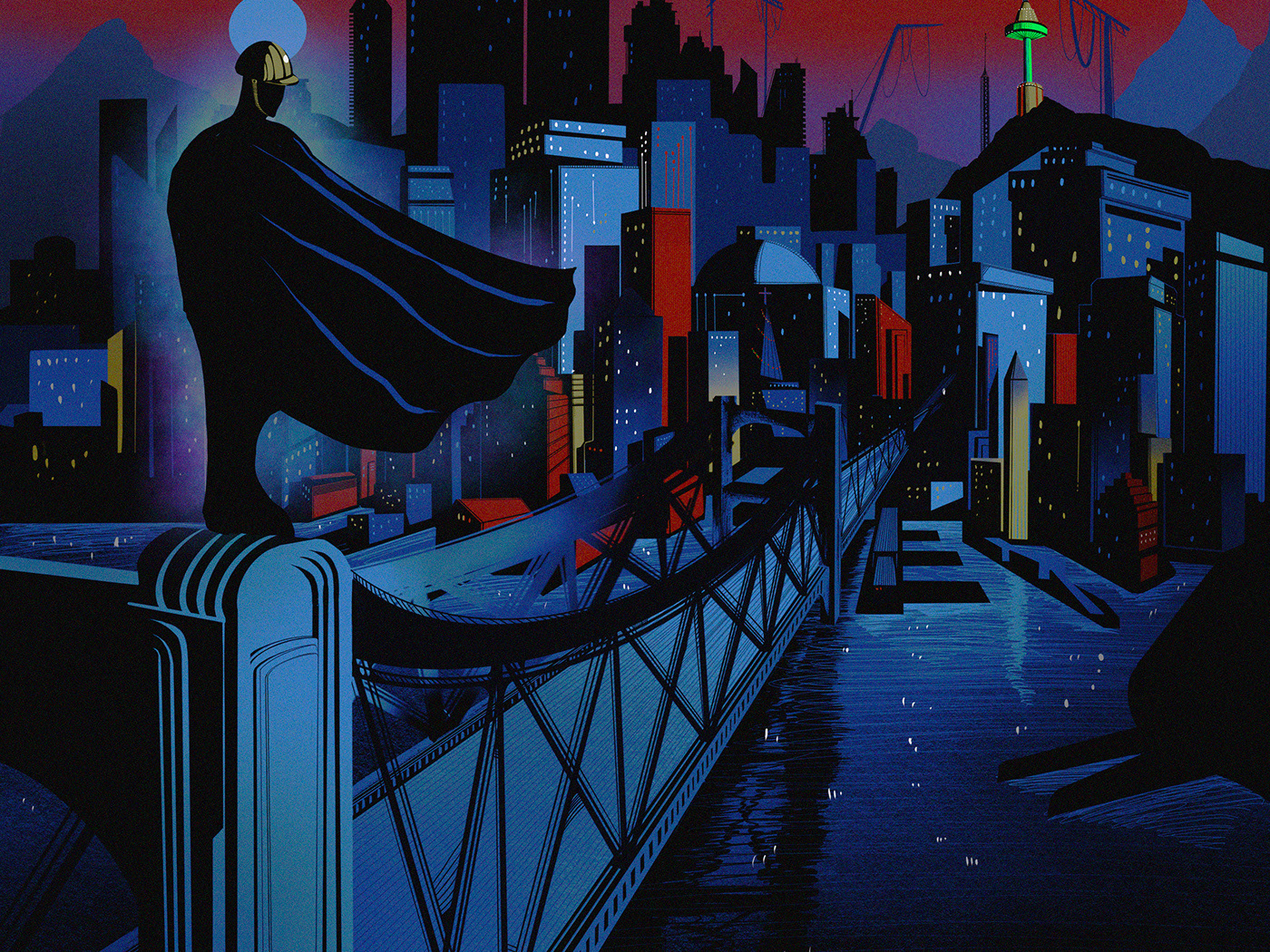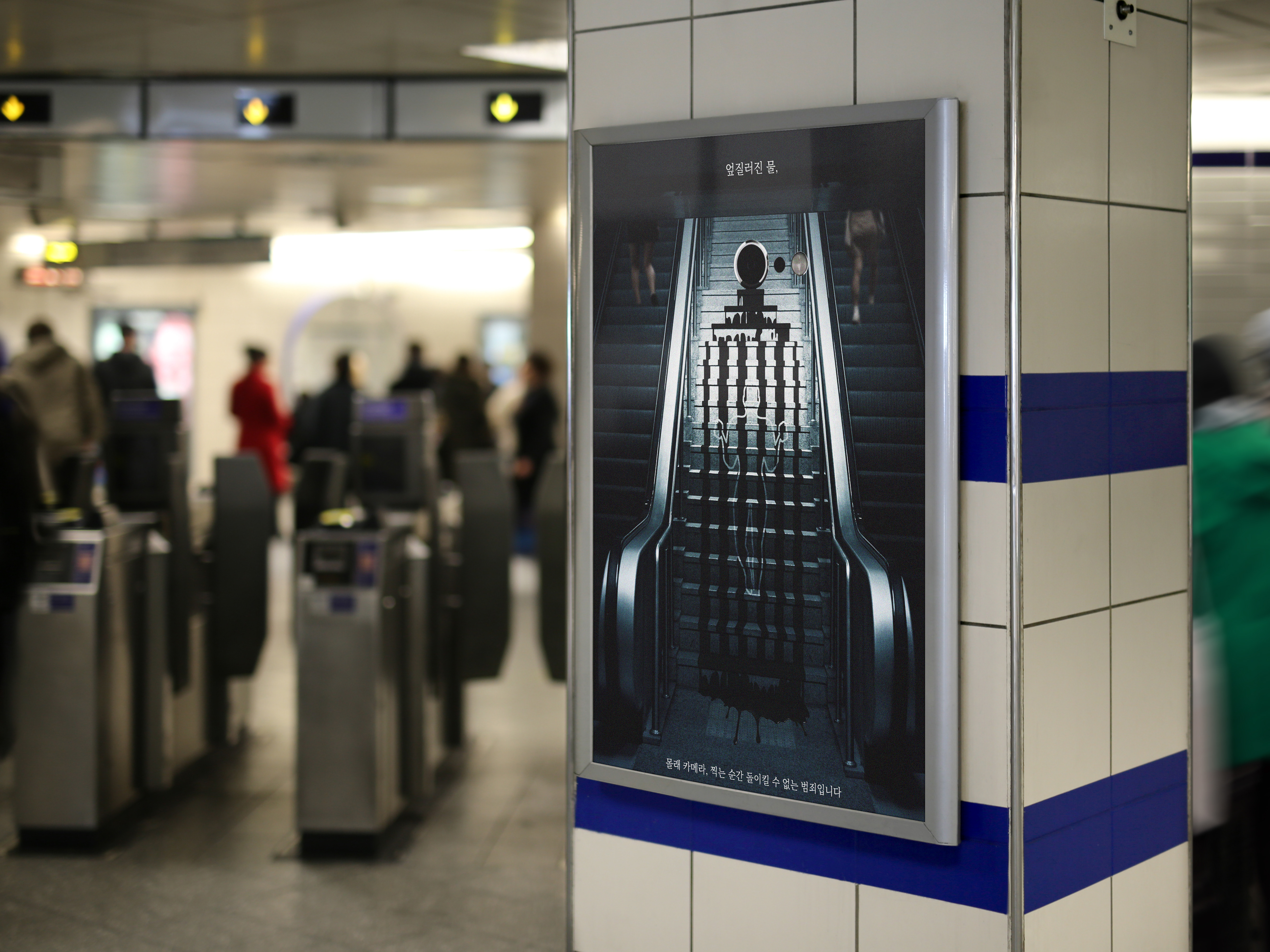<웃음과 우울 #6>
2022, acrylic on the wall, Korea, HanSaem
1.내 주변사람들에게 나는 잘 웃고 재밌는 사람으로 존재했었다.
하지만 나는 누구에게도 말하지 못하는 우울 증세로 인해 병원을 다니고 있었다.
그러던 와중 2021년에 나에게 생각할 시간을 주었던 제주도가 생각이 났다.
(그당시 <오시록헌>을 그리며 한달동안 제주도를 걸음/예술가로 살지에대해 고민하며)
짐을 챙길 필요도 없이 무작정 제주도로 떠나고, 그곳의 화방에서 붓과 라카, 물감을 사서 1주일간 걷는 길에 나의 흔적을 남겼다.
2. 2016년 프랑스에 있을때 같이 축구를 하던 방자망이라는 친구가 있었다. 무척이나 쾌활하고 유쾌하던. 그러던 그친구가 어느날 부터 모습이 보이지 않았다. 훤칠하며 긍정적이던 그가 연인과 이별하여 우울증 증세로 병원에 입원하여 힘든 시기를 보냈다고.
그때 그의 가족들은 그가 병을 가지고 있다는 것을 숨기지 않았으며, 모든 힘을 다해 도왔다.
신기했다, 한국에서 우리사회와는 다르게 그러한 정신병이 감기같이 생각하고 부끄럽지 않게 생각하는게-
우리는 항상 누군가에게 잘 보이려 하고 힘든 일 등의 마음속 깊이 하고 싶은 말은 하지 못한다. 여러 고민들, 제주도 길을 걷는 사람들은 나처럼 생각을 정리하려, 고민을 덮거나 그것의 심연을 파고들기를 하려고 걷는 사람이 많았다.
그들도 언젠가 심연의 길을 걷다가 내가 칠했던 흔적들을 보며 그들처럼 고민과 힘든일이 있는사람이 있었다며 부끄러워 하지마라며, 위로가 되었으면 좋겠다.
As for "Laughter and Melancholy," this series stands out not only for its personal vulnerability but also for its exploration of complex emotional states through visual metaphors. The dual themes of laughter and melancholy are woven throughout the works, showing how these opposing emotions can coexist and shape one’s experience. Each piece in the series highlights the tension between external expressions (laughter) and internal struggles (melancholy). For example, in "Anchor of Depression," the act of laughing is weighed down, symbolizing how difficult it can be to express joy when struggling with deep sadness. The recurring presence of laughter, even in moments of inner turmoil, reflects how people often mask their true feelings with outward smiles.
Hansaem uses vivid imagery to capture these emotional states. For example:
"Anchor of Depression" represents the heaviness of suppressed emotions.
"Balloon Laughter" conveys the lightness and superficiality of outward laughter, almost as if it is disconnected from the person’s deeper emotional reality.
"Waves of Laughter" shows how overwhelming emotions can be, with the waves of laughter threatening to engulf the person.
"Feather Laughter" symbolizes the fragility and pretense of laughter, as light as a feather and devoid of true emotion.
Personal and Universal Struggles: Hansaem’s personal battle with depression gives the series an autobiographical element, but it also taps into universal human emotions. The series is relatable because it portrays the inner conflict that so many people experience—presenting one face to the world while feeling something entirely different inside. His friend Benjamin’s story and his reflections on societal views of mental illness further ground the series in a broader commentary on how emotions and mental health are often misunderstood or hidden.
Hansaem uses vivid imagery to capture these emotional states. For example:
"Anchor of Depression" represents the heaviness of suppressed emotions.
"Balloon Laughter" conveys the lightness and superficiality of outward laughter, almost as if it is disconnected from the person’s deeper emotional reality.
"Waves of Laughter" shows how overwhelming emotions can be, with the waves of laughter threatening to engulf the person.
"Feather Laughter" symbolizes the fragility and pretense of laughter, as light as a feather and devoid of true emotion.
Personal and Universal Struggles: Hansaem’s personal battle with depression gives the series an autobiographical element, but it also taps into universal human emotions. The series is relatable because it portrays the inner conflict that so many people experience—presenting one face to the world while feeling something entirely different inside. His friend Benjamin’s story and his reflections on societal views of mental illness further ground the series in a broader commentary on how emotions and mental health are often misunderstood or hidden.
The fact that Hansaem chose Jeju Island as the location for creating this series adds a layer of symbolism. Jeju Island, often considered a place of reflection and solitude, mirrors the introspective nature of the works. The use of public spaces (walls across different locations) brings the deeply personal subject of mental health into the public sphere, almost as if he’s inviting others to share in his emotional journey. His choice of acrylic and oil paints contributes to the raw, yet textured expression of these emotions. By creating this series in public spaces, Hansaem encourages viewers to engage with the work on a personal level. People walking through Jeju Island might come across these pieces without knowing the full context, but the visual strength of the metaphors invites them to reflect on their own emotional states. The works become part of the environment, much like the emotions they represent, which are often hidden but always present beneath the surface.
Hansaem’s "Laughter and Melancholy" also delves into philosophical questions about human existence:
Hansaem’s "Laughter and Melancholy" also delves into philosophical questions about human existence:
The Mask of Happiness: He questions the authenticity of happiness and how society pressures individuals to maintain a façade, even when they are struggling. This is a universal dilemma, where laughter becomes a survival mechanism, masking deeper pain.
Accepting Melancholy: The series suggests that melancholy is not something to be avoided, but something that can coexist with joy. By embracing both emotions, Hansaem invites viewers to see the beauty in vulnerability and complexity.
Visual and Emotional Contrast:
In each piece, there is a stark contrast between the lightness of laughter and the heaviness of melancholy. Whether it’s through the physical weight of an anchor or the fleeting lightness of a balloon, Hansaem masterfully plays with visual elements to represent emotional states. This contrast reinforces the idea that emotions are multi-layered, and that what we see on the surface is often just a small part of the full emotional landscape.
Accepting Melancholy: The series suggests that melancholy is not something to be avoided, but something that can coexist with joy. By embracing both emotions, Hansaem invites viewers to see the beauty in vulnerability and complexity.
Visual and Emotional Contrast:
In each piece, there is a stark contrast between the lightness of laughter and the heaviness of melancholy. Whether it’s through the physical weight of an anchor or the fleeting lightness of a balloon, Hansaem masterfully plays with visual elements to represent emotional states. This contrast reinforces the idea that emotions are multi-layered, and that what we see on the surface is often just a small part of the full emotional landscape.
"Laughter and Melancholy" is not just an exploration of personal grief and depression—it’s a meditation on the human condition. Through powerful symbolism, Hansaem explores how laughter, even when forced or pretended, coexists with deep emotional struggles. The series shows how we navigate life’s emotional complexities, often masking pain with laughter, and how those experiences shape our understanding of ourselves and the world around us. By placing these works in public spaces, Hansaem turns deeply personal emotions into something shared and communal, suggesting that the journey through melancholy and laughter is not something to be ashamed of, but something to be embraced.
"웃음과 우울"의 경우, 이 시리즈는 개인적 취약성뿐만 아니라 시각적 은유를 통해 복잡한 감정 상태를 탐구한다는 점에서 두드러진다. 웃음과 우울이라는 이중적 주제는 작품 전체에 걸쳐 짜여져 있으며, 이러한 상반되는 감정이 어떻게 공존하여 사람의 경험을 형성할 수 있는지 보여준다. 이 시리즈의 각 작품은 외부적 표현(웃음)과 내부적 갈등(우울) 사이의 긴장감을 강조한다. 예를 들어, "우울의 닻"에서 웃음이라는 행위는 무거운 짐을 지고 있으며, 깊은 슬픔에 시달릴 때 기쁨을 표현하는 것이 얼마나 어려운지를 상징한다. 내면의 혼란 속에서도 웃음이 반복되는 것은 사람들이 종종 겉으로 드러낸 미소로 진정한 감정을 가리는 방식을 반영한다.
한샘은 생생한 이미지를 사용하여 이러한 감정 상태를 포착한다. 예를 들어:
"우울의 닻"은 억압된 감정의 무거움을 나타낸다.
"풍선 웃음"은 겉으로 드러난 웃음의 가벼움과 피상성을 전달하는데, 마치 그것이 사람의 더 깊은 감정적 현실과 단절되어 있는 듯하다.
"웃음 속 파도침"은 웃음의 물결이 사람을 삼키려고 위협하면서 감정이 얼마나 압도적일 수 있는지 보여준다.
"깃털 웃음"은 깃털처럼 가볍고 진정한 감정이 없는 웃음의 연약함과 허세를 상징.
개인적이고 보편적인 투쟁: 한샘의 우울증과의 개인적인 싸움은 이 시리즈에 자서전적 요소를 제공하지만 보편적인 인간의 감정도 활용한다. 이 시리즈는 많은 사람들이 겪는 내면의 갈등을 묘사하기 때문에 공감할 수 있다. 세상에는 한 가지 얼굴을 보여주지만 내면에서는 완전히 다른 것을 느낀다. 그의 친구 벤자민의 이야기와 정신 질환에 대한 사회적 견해에 대한 그의 성찰은 감정과 정신 건강이 종종 오해되거나 숨겨지는 방식에 대한 더 광범위한 논평으로 이 시리즈를 더욱 발전시킨다.
한샘은 생생한 이미지를 사용하여 이러한 감정 상태를 포착한다. 예를 들어:
"우울의 닻"은 억압된 감정의 무거움을 나타낸다.
"풍선 웃음"은 겉으로 드러난 웃음의 가벼움과 피상성을 전달하는데, 마치 그것이 사람의 더 깊은 감정적 현실과 단절되어 있는 듯하다.
"웃음 속 파도침"은 웃음의 물결이 사람을 삼키려고 위협하면서 감정이 얼마나 압도적일 수 있는지 보여준다.
"깃털 웃음"은 깃털처럼 가볍고 진정한 감정이 없는 웃음의 연약함과 허세를 상징.
개인적이고 보편적인 투쟁: 한샘의 우울증과의 개인적인 싸움은 이 시리즈에 자서전적 요소를 제공하지만 보편적인 인간의 감정도 활용한다. 이 시리즈는 많은 사람들이 겪는 내면의 갈등을 묘사하기 때문에 공감할 수 있다. 세상에는 한 가지 얼굴을 보여주지만 내면에서는 완전히 다른 것을 느낀다. 그의 친구 벤자민의 이야기와 정신 질환에 대한 사회적 견해에 대한 그의 성찰은 감정과 정신 건강이 종종 오해되거나 숨겨지는 방식에 대한 더 광범위한 논평으로 이 시리즈를 더욱 발전시킨다.
한샘이 이 시리즈를 제작할 장소로 제주도를 선택했다는 사실은 상징성을 더한다. 종종 성찰과 고독의 장소로 여겨지는 제주도는 작품의 성찰적 성격을 반영. 공공 공간(여러 장소에 걸쳐 있는 벽)을 사용하면 정신 건강이라는 매우 개인적인 주제를 공공 영역으로 가져와 마치 다른 사람들을 자신의 감정 여정에 초대하는 것처럼 보인다. 아크릴과 오일 페인트를 선택하여 이러한 감정을 생생하면서도 질감 있게 표현하는 데 기여한다. 한샘은 공공 공간에서 이 시리즈를 제작함으로써 시청자가 개인적인 차원에서 작품에 참여하도록 장려한다. 제주도를 걷는 사람들은 전체 맥락을 알지 못한 채 이 작품을 마주칠 수 있지만, 은유의 시각적 강점은 시청자가 자신의 감정 상태를 성찰하도록 한다. 작품은 종종 숨겨져 있지만 항상 표면 아래에 존재하는 감정과 마찬가지로 환경의 일부가 된다.
한샘의 "웃음과 우울"은 또한 인간 존재에 대한 철학적 질문을 탐구한다. 행복의 가면: 그는 행복의 진정성과 사회가 개인이 어려움을 겪을 때조차도 겉모습을 유지하도록 압력을 가하는 방식에 의문을 제기한다. 이는 보편적인 딜레마로, 웃음이 생존 메커니즘이 되어 더 깊은 고통을 가린다.
우울함 수용: 이 시리즈는 우울함이 피해야 할 것이 아니라 기쁨과 공존할 수 있는 것이라고 제안한다. 한샘은 두 가지 감정을 모두 수용함으로써 시청자에게 취약성과 복잡성의 아름다움을 보도록 초대한다.
시각적 및 감정적 대조:
각 작품에서 웃음의 가벼움과 우울의 무거움 사이에 뚜렷한 대조가 있다. 닻의 물리적 무게를 통하든 풍선의 덧없는 가벼움을 통하든 한샘은 시각적 요소를 능숙하게 사용하여 감정 상태를 표현한다. 이러한 대조는 감정이 다층적이며, 우리가 표면적으로 보는 것은 종종 전체 감정적 풍경의 작은 부분일 뿐이라는 생각을 강화한다.
우울함 수용: 이 시리즈는 우울함이 피해야 할 것이 아니라 기쁨과 공존할 수 있는 것이라고 제안한다. 한샘은 두 가지 감정을 모두 수용함으로써 시청자에게 취약성과 복잡성의 아름다움을 보도록 초대한다.
시각적 및 감정적 대조:
각 작품에서 웃음의 가벼움과 우울의 무거움 사이에 뚜렷한 대조가 있다. 닻의 물리적 무게를 통하든 풍선의 덧없는 가벼움을 통하든 한샘은 시각적 요소를 능숙하게 사용하여 감정 상태를 표현한다. 이러한 대조는 감정이 다층적이며, 우리가 표면적으로 보는 것은 종종 전체 감정적 풍경의 작은 부분일 뿐이라는 생각을 강화한다.
"웃음과 우울"은 단순히 개인적인 슬픔과 우울증에 대한 탐구가 아니라 인간의 상태에 대한 명상일 수도 있다. 강력한 상징주의를 통해 한샘은 웃음이 강요되거나 가장된 경우에도 깊은 감정적 갈등과 공존하는 방식을 탐구한다. 이 시리즈는 우리가 종종 웃음으로 고통을 가리는 삶의 감정적 복잡성을 어떻게 헤쳐 나가는지, 그리고 그러한 경험이 우리 자신과 주변 세계에 대한 이해를 어떻게 형성하는지 보여준다. 한샘은 이러한 작품을 공공 장소에 배치함으로써 깊이 있는 개인적인 감정을 공유되고 공동체적인 것으로 바꾸어 우울과 웃음을 통한 여정이 부끄러워할 일이 아니라 받아들여야 할 일임을 시사하려한다.
#1 우울의 닻
웃으려고 애를 쓸 때마다 나는, 가라앉는 느낌이 들었다.
#2 풍선 웃음
남들 앞에서 내가 웃는 것은, 참으로 가벼운 감정에서 비롯된 것이다.
#3 고독의 웃음
밤마다 속으로 울부 짖는다, 하지만 외로운 내 웃음만이 비웃듯 날 비춘다.
#4 웃음속 파도침
웃을려고 애쓸때마다 파도는 나에게 치고 또 넘쳐버려 흘러내리고 만다
#5 깃털 웃음
나의 눈 웃음은 가식의 깃털처럼 가벼웠다.
#6 웃음 말기
억지웃음은 나를 더이상 버티지 못하게 만들었고 우울을 뱉어버렸다.









